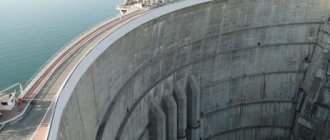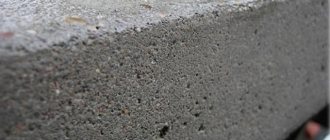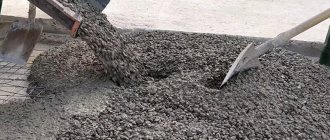Industrial construction does not stop during the cold season, but concrete hardening at subzero temperatures is problematic. Crystallization of water leads to a decrease in strength, which negatively affects the quality of structures. The use of antifreeze additives in concrete, a wide selection of which the industry offers today, will help solve the problem.
Operating principle
The use of antifreeze additives allows you to pour mortars at temperatures down to -50ºС. They are liquid or powdery formulations added to the mixture. It is important to know that concrete additives added during frost provide only 30% hardening. Final hardening occurs after the monolith is defrosted.
There are several types of antifreeze additives, differing in their principle of action:
- Compositions that lower the freezing point of the liquid, as a result, the process of cement hydration continues, setting proceeds according to the standard mechanism;
- Sulfate-based additives accelerate the compaction of concrete, which releases excess heat, increasing the rate of cement hydration;
- Complex additives increase the solubility and activity of cement laitance, while compounds resulting from the reaction with water reduce its crystallization temperature.
Video description
Watch a video testing paving slabs made with and without a hydrophobic additive:
Other Supplements
Additives to cement can have other purposes, have a special or complex effect.
- Anti-corrosion additives give concrete resistance to acids and poorly soluble compounds, protect reinforcement and elements of removable and permanent formwork, and other metal structural elements in contact with concrete from rusting.
- Additives that improve the self-compaction of concrete make it possible to create thin-walled products and structures with a large number of reinforcing elements.
- Air-entraining additives slow down the evaporation of moisture from molding products, stimulating complete hydration of the cement.
- Multifunctional chemical additives for concrete have a complex effect and improve several of its characteristics at once.
Complex waterproofing additive Source promindex.ru
Varieties
There are various antifreeze additives, each of which has its own mechanism of action. A popular additive is sodium carbonate, otherwise called potash. This is a powdery crystalline composition that accelerates the hardening of the concrete mixture. The use of an additive of this type reduces the technical characteristics of the material, including strength. To reduce this effect, sodium tetraborate is added to potash.
Attention! Potash is classified as a hazardous substance, therefore safety requirements are observed when working with it.
Sodium tetraborate is a complex substance consisting of sodium and calcium salts with the addition of ammonium. This is an additional antifreeze additive used with sodium carbonate. Without it, the structure can lose up to 30% of its strength after thawing and complete hardening.
Sodium nitrite is an effective antifreeze additive that reduces the crystallization temperature of water, accelerates the hardening of the composition, and has an anti-corrosion effect. Its use is dangerous, since sodium nitrite powder is a flammable, explosive, toxic substance. Used in frosts down to -25ºС. It cannot be mixed with lignosulfonic acids, since it releases toxic gas when interacting with them. Calcium nitrite has similar properties.
Sodium formate is an antifreeze additive for concrete, reducing the crystallization temperature of water and accelerating the hydration of cement. It is added in a proportion of no more than 6% of the total mass of concrete. To improve plasticization, naphthalene lignosulfonate is added to the additive.
Urea is a PMD, prolongs the liquid phase of water, and has virtually no effect on the setting speed.
Calcium and sodium chlorides, ammonia water reduce the freezing point, but have an increased corrosive effect. They have a strong effect on metal elements and are therefore not recommended for use in reinforced concrete products.
Tips for choosing
When choosing antifreeze additives, they take into account the method, circumstances of operation of the concrete structure, ambient temperature, brand, composition of cement, and quality of the additive. The PMDs used by specialists the most are considered optimal:
- potash (7% concentration) is suitable for Portland cement;
- sodium nitrite;
- sodium chloride is used for rapid hardening modifications.
When choosing PMD, you need to pay attention to the experience, image of the manufacturer, reviews in order to avoid purchasing a low-quality product.
How to use
The choice of additive and the method of its application depends on the condition and material where it will be introduced. Any additives to concrete used at sub-zero temperatures are added to the solution with water, according to the instructions from the manufacturer. After thorough mixing, it is recommended to wait a while for this component to diffuse through the composition.
According to SP 70.13330.2012, in order for the composition to achieve the required strength, it is important that before the temperature of the composition reaches the level for which the additive is designed, it gains no more than 20% of the planned strength.
The consumption of antifreeze additive per 1 cubic meter of material depends on the average daily ambient temperature. Up to -5 degrees it is recommended to add up to 2% of the additive by weight of the solution, up to -10 degrees this figure increases to 3%, up to -15 degrees no more than 4%. In severe frosts, calculations are made individually for each type. The rate of hardening of the solution decreases, and maximum strength is achieved after the end of frost.
When adding plasticizers and PMD, certain operating rules must be followed. The recommended range for the solution to be poured is from +15 to +25ºС. To dissolve additives, a certain amount of water is required, which must be heated, this ensures complete dissolution of the substances. Sand and crushed stone used in the solution are also heated immediately before adding. Cement cannot be heated, as it will lose its astringent properties. The poured solution must be covered, this is especially true during snowfall.
Application benefits
- the liquid present in the mixture freezes at lower temperatures than normal, allowing the solution to set;
- the solution becomes more plastic - it is easier to form individual parts of the structure;
- reinforcement in reinforced concrete structures does not oxidize due to corrosion inhibitors present in the additives;
- the water resistance of reinforced concrete increases;
- the mixture becomes strong in a shorter time.
Concrete hardens faster in cold weather - one of the advantages.
After adding the additive to the solution, the mixture becomes more dense due to the saturation of micropores in the concrete with carbonated calcium hydroxide, and it becomes easier to pour it into the mold. The strength of the structure is doubled. 18 hours are enough for the concrete structure to fully harden. Extraction takes place without damaging the integrity of the concrete. High-quality PMDs do not allow the appearance of “salt” on the surface.
The use of antifreeze additives allows you to:
- mix the solution with low-grade concrete, reducing material costs;
- make thinner layers of concrete without risking the quality of the structure (due to increased strength) - the solution is saved;
- concrete will not need treatment with waterproofing agents.
Return to contents
Advantages and disadvantages of additives
The main advantage of concrete with anti-frost additives is the ability to perform work all year round. Selected in the correct proportion, they improve the adhesion of the components, increasing the quality of the solution. They have other advantages:
- increasing service life due to concrete compaction;
- increase the plasticity of mixtures, making them easier to work with;
- the frost resistance of ready-made concrete increases, which is important for elements of load-bearing structures;
- the use of PMD is the cheapest method of filling at subzero temperatures;
- the use of additives reduces shrinkage during solidification, maintaining the integrity of the structure;
- anti-frost additives fill the pores of concrete, thereby significantly increasing its water resistance;
- some compositions significantly increase the corrosion resistance of the monolith, extending the service life of structures, buildings and structures significantly.
The use of antifreeze additives also has its disadvantages. If used incorrectly, the strength characteristics of concrete are reduced, so when working, you must strictly adhere to the instructions. Some additives are flammable and toxic, which must be taken into account when working with them. Even with additives, in frosty conditions the hardening rate will be relatively low. To achieve the required strength when laying in winter, a larger amount of cement is required, which increases the cost of construction.
Concreting technology
Winter concrete must be prepared correctly. It is recommended to add the antifreeze additive to the concrete mixture, having previously dissolved it in water. Laying the mixture is carried out in compliance with the following rules:
To avoid the formation of joints and delaminations, it is necessary to pour the concrete mixture continuously.
- If it is snowing outside, it is recommended to make a shelter over the place where the concrete is poured.
- The solution coming out of the mixer should be in the range of +15 - +20 °C in terms of heat.
- It is recommended to heat the water for preparing the frost-resistant mixture.
- It is recommended to pour the solution continuously to avoid the formation of joints.
If it is not possible to purchase a ready-made additive, chloride salt can be used as an antifreeze additive. However, it is important to keep in mind that the use of this method is only permissible if the concrete structure does not have metal reinforcement.
Do-it-yourself anti-frost additives
In private construction, if it was not possible to carry out all the work in the warm season, it is necessary to continue in the winter. Therefore, it is allowed to prepare antifreeze additives for concrete with your own hands at home. To do this, you only need table salt or sodium chloride. This additive reduces the freezing point of water and reduces the critical hardening time of the mixture.
To make an anti-frost additive for concrete with your own hands, salt is dissolved in water and added to the solution. Concentration up to -5 degrees is 2% by weight of the solution, up to -15 degrees, the mass fraction of chloride reaches 4%.
The disadvantage of this additive is its corrosion activity towards metal, so it is not suitable for reinforced concrete structures. It must be taken into account that the rate of hardening of the solution at negative temperatures will be, on average, 3 times lower than under normal conditions.
Chemicalization of winter. Antifreeze additives in concrete: trends, recommendations, opinions
Text: Denis Bannikov
Winter is coming and Russia is doomed. In conditions when most of the country stays in the zone of negative temperatures for half a year, it is simply doomed to build in winter and conduct winter concreting. Builders have no other chance to optimize the investment cycle.
According to various estimates and depending on the state of the market over the past five years, the share of winter concreting in the total volume of construction ranges from 10 to 17%. This is a solid jackpot for manufacturers and suppliers of construction chemicals, and, in particular, those additives that should ensure the efficiency of the process at subzero temperatures. On the other hand, it was manufacturers who influenced the growth of winter construction. The interest here is mutual.++++
Note that the term “winter concreting” itself is conditional, since it does not determine the ambient temperature in which the concrete hardens. More precise terminology of “concreting conditions at low temperatures” is defined in SNiP 3.03.1 1 -87 for load-bearing and enclosing structures.++++
Research on chemical and physical methods for ensuring the hardening of structures at low and negative temperatures has been carried out in the USSR since the 30-40s of the last century. But as a result, the use of antifreeze additives in concrete mixtures was either limited or even prohibited by regulatory documents protecting both durability and other quality indicators of concrete structures. For transport construction projects, SNiP 3.06.04-91 completely prohibits the use of antifreeze additives almost everywhere. ++++
The intensification of the winter concreting process began only in the 90s, when completely new products appeared on the market that made it possible to regulate not only the kinetics of concrete strength gain at low and negative temperatures, but also a number of other rheological properties of the concrete mixture. ++++
Today, additives in concrete with an anti-frost effect make it possible to carry out concreting even at -25°C, ensuring the process of formation of cement stone and, as a consequence, hardening of concrete. Thus, the main task of modern antifreeze additives is to reduce the setting time of cement and speed up the hardening time of concrete, and lower the freezing point of water. ++++
However, the process of concreting in winter is a whole complex of measures, including not only the preparation of the concrete mixture, but also the method of laying and measures for caring for the laid concrete. So the use of additives is intended to facilitate the process of preparing and laying the concrete mixture, but in no case cancels the entire range of necessary measures.++++
CHEMISTRY OF COMPOSITION
Today, about 800 types of concrete additives are produced in the world, each additive has certain properties and a specific purpose, and can often work in combination, including in winter construction conditions:++++
- Plasticizers;
- Superplasticizers;
- Reinforcing additives;
- Retarders;
- Hardening accelerators;
- Pigments;
- Air-entraining additives;
- Antifreeze additives for concrete.
According to GOST 24211-2008 “Additives for concrete and mortars. General technical conditions" anti-frost additives are divided into anti-frost for "cold" and for "warm" concrete and mortar, which greatly influences the choice of both the additive itself and the concreting technology, often putting concrete producers and consumers in a difficult position.++++
In general, traditional and widely used antifreeze additives are a number of technically qualified salts: table salt NaCl, calcium chloride CaCl2, sodium nitrite NaNO2, sodium nitrate NaNO3, calcium nitrate Ca(NO3)2, potash K2CO3, soda ash Na2CO3, sodium formate NaCOOH , urea.++++
Potash significantly accelerates the setting and hardening of concrete and is used for construction work in winter, if during curing until critical strength is achieved, the temperature of the concrete with the maximum dosage of the additive does not drop below 25oC.++++
The disadvantages of potash include:++++
- Concrete mixtures with potash are characterized by very short setting times.
- Crystallization of salts (hydrocarbonaluminate, bicarbonate and calcium carbonate) formed during the interaction of potash with cement hydration products occurs with an increase in volume, which can significantly reduce the frost resistance of concrete.
- Caustic alkalis formed during hardening of concrete with the addition of potash can cause alkaline corrosion of concrete.
- As a result of the interaction of amorphous or poorly crystallized silicic acid with caustic alkalis, internal stresses appear in concrete, which can exceed the tensile strength of the aggregate or cement stone and cause the appearance of micro- and macrocracks up to the destruction of the structure.
- Concrete with the addition of potash, subjected to electrical heating, loses up to 30% of its strength compared to unheated concrete and has low frost resistance and water resistance.
Sodium nitrite is used as an anti-frost additive if, during curing until critical strength is acquired, the temperature of the concrete, with the maximum allowable dosage of the additive, does not fall below 15oC. ++
Sodium nitrite is a salt of nitrous acid, all salts of which are highly toxic. According to the degree of impact on the body, technical sodium nitrite belongs to substances of the 3rd hazard class. The maximum permissible concentration of nitrogen oxides in terms of NO2 in the air of the working area is 5 mg/m3 (0.005 mg/l). This determines the need to supply sodium nitrite solution to supply containers and concrete mixers only through pipelines, and containers for preparing, storing and transporting powder and solutions at concrete factories and on construction sites must be marked with the warning sign “Poison!”.++++
Therefore, despite the satisfactory technical performance of concrete with the addition of sodium nitrite, the main and very serious drawback is its physiological and environmental hazard.++++
When carrying out concrete work, it is also necessary to take into account that sodium nitrite is an oxidizing agent and, for example, when used together with LST lignosulfonates, naphthalene lignosulfonate C-3 and the addition of SDB, poisonous gases can be released - nitrogen oxides NO and NO2.++++
Sodium formate is used in cases where, during curing until critical strength is acquired, the temperature of the concrete with the maximum dosage of the additive does not fall below 15°C.++++
Sodium formate belongs to substances of the 3rd hazard class with a maximum permissible concentration in the air of the working area of 10 mg/m3 and, like sodium nitrite, is an additive whose use must be treated with caution. A significant technological disadvantage of sodium formate is the need to dissolve it in warm water before use.++++
Sodium formate changes the solubility of the silicate components of cement and forms double or basic salts with the products of its hydration, the crystallization of which occurs with an increase in volume, the accumulation of local defects in certain zones of structures and the destruction of these zones.++++
A common disadvantage of potash, sodium nitrite and sodium formate and other antifreeze and hardening-accelerating additives that do not have a plasticizing and water-reducing effect is that they are traditionally used together to increase the mobility of concrete mixtures, reduce the water/cement ratio and reduce internal stresses in concrete with plasticizing additives, which increases the cost of concreting.++++
However, the building materials market today offers a whole range of complex antifreeze additives for concrete and mortars. The promise of complex modifiers from modern manufacturers is obvious, since they make it possible to influence several properties of concrete mixtures and concretes and obtain a high synergistic effect. ++++
New generation concrete additives combine the properties of plasticizers, hardening accelerators and antifreeze additives. They stabilize and plasticize the mixture, accelerating the strength gain of concrete in the initial stages. At the same time, their use increases both the thixotropy of the mixture and the grade strength of concrete (by 2 classes). ++++
For example, air-entraining additives promote the formation of air microbubbles, which significantly increases the frost resistance of concrete - due to the space that can be occupied by water expanding during freezing and penetrating into the concrete. As a result of air entrainment (approximately 4.5±1.5%), the compressive strength of concrete is slightly reduced (1% air entrainment reduces the compressive strength of concrete by 3%), but at the same time its workability improves.++++
The entrained air content is usually 4-5%. In this case, the strength of concrete practically does not decrease, since the negative effect of entrained air is neutralized by increasing the strength of the cement stone due to a decrease in the water-cement ratio due to the plasticizing effect of the additive. The air-entraining additive hydrophobizes the pores and capillaries of concrete, and air bubbles serve as a reserve volume for freezing water without causing large internal stresses. As a result, the water resistance and frost resistance of concrete are significantly increased. Air-entraining admixtures are more effective in concrete with low cement consumption.++++
By the way, at the beginning, when air-entraining additives were introduced into concrete to give it frost resistance, it was noticed that these substances impart other useful properties to the concrete mixture: they reduce (and under favorable circumstances can completely eliminate) the formation of cracks during plastic shrinkage, reduce erosion by water, improve workability.++++
Concrete hardening accelerator is a complex additive that belongs to superplasticizers. Usually these are aqueous solutions of chloride salts (for example, calcium chloride, sodium, etc.). They affect the solution, activating the process of clinker hydration, which leads to faster hardening of concrete. Accelerator additives are used to produce quick-setting concrete, increase the strength of concrete at an early age and when performing work in winter.++++
Plasticity regulators significantly extend the time of use of ready-made concrete mixtures during long-term transportation.++++
The optimal dosage of the additive depends on the type of cement, the composition of the concrete mixture, and the manufacturing technology of the structure. Typically used (% by weight of cement): plasticizing additives - 0.1-0.3; superplasticizers - 0.5-1; air-entraining additives - 0.01-0.05; hardening accelerators – 1-2. In practice, the optimal dosage of the additive is determined experimentally.++++
At one time, Alexander Galtsev, leading process engineer at CSL Elgad-TOP (Moscow), now chief technologist at Euroconcrete, drew attention to the fact that the prospectuses of a number of manufacturers of antifreeze additives promised extraordinary ease in performing winter work and improved properties of the final product - reinforced concrete structures. “The courage of the creators of the new generation of supplements and the pace of expansion of the offered range are at the same time surprising, inspiring and alarming. But the main thing for the consumer is not disclosed: what and when is this or that additive good for? After all, additives for “warm” and “cold” concrete (according to GOST 24211-2008 classification) are fundamentally different. ++++
But do consumers know these subtleties? Do all manufacturers of concrete mixtures know about this when they buy praised additives for their products? And often people find themselves in hopeless situations when, hoping for a quick completion of concrete work at subzero temperatures, they buy concrete with an antifreeze additive, not knowing that such an additive only works during transportation and laying of the concrete mixture. ++++
But heating of the concreted mass is mandatory, as for concrete without additives. Otherwise, you will end up with a frozen piece of concrete that will never gain its design strength when thawed. Not a single additive can be put into production today without studying its effect by all available means in consumer laboratories on the specific materials they use. The beginning of any research is the elementary combination of the proposed additive with a small amount of cement and water. In a minute you can already determine whether it is worth working with this additive further. If there is a strong smell of ammonia, it is better not to use this additive for further development,” the expert notes.++++
As noted in the publication of the journal “Concrete Technologies”, Alexander Vlasenko, General Director of LLC “UK “Group of Enterprises “SKT-Standard”” (Moscow Region): “... For different construction processes, the ways to solve the problem are different. Thus, for cement mortars it is important to lower the freezing point of water, i.e. keep them operational and prevent them from freezing when laying. ++++
For monolithic work, the following requirements are put forward for the concrete mixture: deliver the material to the site, place it in the side equipment, carry out heating and ensure strength gain at a positive temperature to the required critical strength. And the use of antifreeze additives is not a panacea, but one of the measures of an integrated approach to solving the above problems in this area. The attitude towards the use of these additives can be characterized by the phrase “help without harm.” ++++
MARKET CHEMISTRY
According to various experts, the share of the use of antifreeze additives, incl. complex ones, when concreting in winter ranges from 60 to 80%: “Now in Russia additives are used in less than 60% of cases, while in Europe this figure reaches 90%,” says Daria Pichugina, an analyst at the Investkafe agency. In her opinion, the demand for this type of product in Russia will constantly grow.++++
There are indeed a large number of additive manufacturing companies on the market. For example, the Internet resource https://beton.ru/ presents a classification of approximately 200 specialized companies. On the resource https://mirmonolita.ru/specialization/all/dobavki-i-pigmenty there are more than 450. Although in both cases it is quite difficult to identify the manufacturer and just the supplier. Moreover, the manufacturers themselves, most often, offer a large range of construction chemicals in general, and not just antifreeze additives.++++
According to experts, the supplement market is very saturated, and competition between participants is quite high. The share of the main players accounts for up to 80% of the total volume. For example, according to Investcafe, the largest market share in St. Petersburg (about 52%) is occupied by Tsemaktiv (according to various estimates, the market share ranges from 15 to 20%). Among foreign companies, the leaders are German manufacturers MC‑Bauchemie, BASF, and Swiss Sika - 6% each of the total market share.++++
According to the General Director of the Agency for Effective Procurement "ExPro" Oleg Soltanov, the main trend in recent years in the additives market is, on the one hand, improving the quality of domestically produced products, including through the use of imported components. ++++
On the other hand, the development of production in Russia by many importers follows the same pattern: the base is imported, and the additive itself is mixed at local production. Due to this, the import of ready-made additives has decreased significantly, the analyst notes.++++
CHEMISTRY PROBLEMS
One of the problems is the relationship between foreign and domestic additives at the local level. The results of numerous studies of foreign additives conducted by Russian laboratories have shown that no matter how well they have proven themselves in the West, this does not mean that in Russia, on domestic inert materials and cement, they will show good results. ++++
It must be borne in mind that abroad the quality of cement and other concrete components is very high. In particular, great attention is paid to the grain composition of crushed stone and even sand.++++
The experience of producers has shown that imported additives in some cases do not work well, both with domestic cements and in combination with domestic additives. For example, some Swedish superplasticizers are incompatible with those domestic ones that provide frost resistance to concrete. That is, having chosen one additive from a foreign company, manufacturers, as a rule, are forced to use other additives from the same manufacturer. And this is not profitable from an economic point of view.++++
Alexander Bogza, former commercial director, now general director of the ANO Moscow Center for Structural Transformations of Industry, identified several more pressing problems in this area:++++
Lack of detailed recommendations on the use and dosage of antifreeze additives. For small and mobile manufacturers, it is not possible to have their own testing laboratory, conduct expensive formulation development and research, so for them it is of great importance to have detailed recommendations on the dosage of anti-freeze additives in concrete production. ++++
The additive behaves differently, reacting with other components of the concrete mixture. This largely depends on the brand and manufacturer of cement and the type of filler (granite, gravel, limestone, quartzite-sandstone, etc.) In this regard, there is a need to have information on options, dosages and the possibility of combining an antifreeze additive with other modifiers and raw materials. ++++
Reducing the required dosage of the antifreeze additive. Reducing dosages, on the one hand, increases the productivity of the enterprise, and on the other, helps reduce costs not only for the antifreeze additive itself, but also for its transportation and, as a consequence, the cost of the final product, which in conditions of healthy competition is a significant advantage.++ ++
Development of anti-frost additives that make it possible to preserve concrete for a longer time when transporting to a construction site under winter concreting conditions.++++
Antifreeze additives can cause corrosion of reinforcement, negatively affecting the durability of reinforced concrete structures. In this regard, antifreeze additives are not used in transport construction. Reducing the negative impact on reinforcement is another direction in the field of improving the quality characteristics of antifreeze additives.++++
Introduction of environmental properties for antifreeze additives. There can be no question of the environmental friendliness of concrete as long as additives containing chlorine compounds are used, which has a harmful effect on both the human body and the environment.++++
Materials from the journal “Concrete Technologies” and other open sources were used
How to change the properties of concrete using improvised means
People have always thought about improving the strength and durability of hardening building mixtures. There is information that in the old days masonry and plaster mortars were mixed using chicken eggs, which made them more dense, flexible and durable. It is difficult to say whether this is true, and it is unlikely that modern developers will incur such expenses.
However, many craftsmen believe that household detergents, rather than special chemicals, can be added to cement for strength and ductility. Less expenses, but the same result. Dishwashing detergents, liquid soap or washing powder dissolved in water are used as household plasticizers.
Fairy is the most popular home plasticizer Source setam.net.ua
Everyone knows that salt prevents water from freezing. And they apply this knowledge when mixing concrete in winter, increasing its frost resistance with the help of ordinary table salt. The main thing here is not to overdo it and not to add more than 2% of the volume of the dry mixture.
Plastering walls
In order to prepare the plaster, it is also important to maintain the correct proportions. According to its composition, plaster is divided into three main types: thin, normal and greasy.
The largest volume of cement is contained in the fatty mixture.
Solution
To carry out plastering work, it is necessary to prepare a solution that will contain M-400 cement. The ratio of this solution is as follows: one part cement, five parts sand, lime mortar. The correctness of the prepared solution lies in its easy draining from the spatula when placed in a completely vertical position. In order to prepare decorative plaster, you should add pigment paint, which can be purchased in various colors, to the basic ready-made solution.
Working with solution
The prepared solution is applied to the wall using a special trowel. The applied mixture must be leveled using a rule. After completing this process, it is necessary to grout the entire wall. This action is performed using a grater, which is moved on the surface in a circle. If there are any deficiencies, it is necessary to reapply the solution, and then re-grout the area. In order to prevent cracking of the plaster layer, it is necessary to water it with water during work.
Foundation cement
You can find a large number of types of cement in the construction market. It is sold both in its pure form and filled with various additives that include useful characteristics. In order to fill the foundation, it is more advisable to use Portland cement or cement containing mineral and active additives. The brand of material also plays an equally important role.
Material calculation
In order to calculate the amount of cement that will be needed during the work process, it is enough to know the volume of concrete, as well as the content of the remaining components of the mixture. It is even easier to determine the volume of concrete, since here it is enough to measure all sides of the formwork and carry out some calculations. Based on the basic proportion that is used when preparing the mortar for the foundation, you need to take one part of cement (preferably using the M-500 brand), combine it with three parts of sand and one part of crushed stone, and fill it all with half of the water.
Preparation of the solution
In order to prepare a solution for pouring the foundation, you will need the following components:
- 45 liters of water;
- 10 kg of cement;
- 30 kg of sand;
- 50 kg of gravel.
All these components must be combined and mixed thoroughly. If the solution turns out to be too thick, additional addition of a small amount of water is allowed.
Overview of concrete protection additives
To protect concrete from external factors, a variety of materials for various purposes are usually required. Waterproofing, insulation and cladding are difficult to apply, although they provide concreting with durability. As a result, construction takes longer, becomes more complicated and becomes more expensive. But it is possible and easier to turn a classic solution into something more advanced if you buy special additives for concrete mixtures.
- Finely ground - allows you to reduce the cement content in the solution and thereby reduce the cost of concrete by 10-15 percent. At the same time, they increase its density and frost resistance, partially taking on the same functions as strengthening and waterproofing additives.
- Chemical - this group of additives and modifiers is very numerous and deserves special attention.
If the main components of the mixture are not able to provide the monolith with the necessary properties, chemical additives for concrete of a suitable purpose are needed. In our review we will look at their types and compare their characteristics.
When it is necessary to adjust the behavior of a solution in several directions at once, it is advisable to select complex concrete additives that are suitable in composition and characteristics. Without them, such problems are more difficult to solve, because you will have to look for modifiers that will not “conflict” with each other.
The lion's share of profile additives, regardless of their main purpose, also has a complex effect. After all, all the properties of concrete are closely related to each other - as soon as one of them changes, the others inevitably react to it.
Thus, antifreeze additives simultaneously function as setting rate regulators. And superplasticizers, which increase strength due to compaction, thereby improve water resistance. Continuing the logical chain, we note that good waterproofing provides concreting with better frost resistance.
Briefly about the main thing
Concrete can have different characteristics depending on the brand of cement, the proportions of its components, the correct preparation, and the maturing conditions. These characteristics can be changed at your discretion, if you know that there are special additives for concrete: for strength, for increasing ductility and hardening speed, for resistance to water and low temperatures. The introduction of a small amount of these substances into the solution makes it possible to simplify concrete work and increase the durability of buildings, structures and concrete products.










